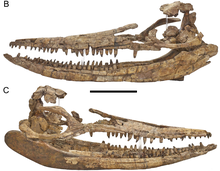| Protoichthyosaurus Temporal range: Early Jurassic,
| |
|---|---|

| |
| Reconstructed skull (BMT 1955.G35.1) of P. prostaxalis | |
| Scientific classification | |
| Domain: | Eukaryota |
| Kingdom: | Animalia |
| Phylum: | Chordata |
| Class: | Reptilia |
| Order: | †Ichthyosauria |
| Family: | †Ichthyosauridae |
| Genus: | †Protoichthyosaurus Appleby, 1979 |
| Type species | |
| Protoichthyosaurus prostaxalis Appleby, 1979
| |
| Other species | |
| |
Protoichthyosaurus is a genus of ichthyosaur from the early Jurassic of southern England and possibly Switzerland. Two species are known, P. prostaxalis—the type species, named by Appleby in 1979[1]—and P. applebyi.[2] A third species, P. prosostealis, was named by Appleby,[1] but it was removed from the genus in 2017 due to its similarity to Ichthyosaurus.[2] The genus Protoichthyosaurus was synonymized with Ichthyosaurus by Maisch and Hungerbuhler in 1997, and again by Maisch and Matzke in 2000.[3][4] However, it was found to be distinct in 2017 by Dean Lomax and colleagues, who separated it from Ichthyosaurus on account of differences in the arrangement and shape of the carpal ossifications, as well as the absence of the fifth digit. The species most likely lived during the Hettangian stage, but may have lived as early as the Rhaetian and as late as the Sinemurian.[2]
Species belonging to the genus were medium-sized, with P. prostaxalis measuring no more than 2.5 metres (8 ft 2 in) in length and P. applebyi reaching 2 metres (6 ft 7 in) at most. P. prostaxalis can be distinguished from P. applebyi and from other ichthyosaurs by the large, tall, and triangular maxilla that extends beyond the nasal bones at its front end; a vertically short but thick postorbital bone; and the lacrimal bone having an upward projection longer than its forward projection. Meanwhile, P. applebyi can be distinguished by the narrow, crescent-shaped postorbital; the low maxilla; the nasal reaching to the front of the maxilla; the lacrimal having a forward projection the same length as or longer than the upward projection; and the presence of a plate-like upward projection on the humerus.[2]
- ^ a b Appleby, R.M. (1979). "The affinities of Liassic and later ichthyosaurs". Palaeontology. 22: 921–946.
- ^ a b c d Lomax, D.R.; Massare, J.A. & Mistry, R.T. (2017). "The taxonomic utility of forefin morphology in Lower Jurassic ichthyosaurs: Protoichthyosaurus and Ichthyosaurus". Journal of Vertebrate Paleontology. 37 (5): e1361433. doi:10.1080/02724634.2017.1361433. S2CID 90238537.
- ^ Maisch, M. W.; Hungerbühler, A. (1997). "Revision of Temnodontosaurus nuertingensis (v. HUENE, 1931), a large ichthyosaur from the Lower Pliensbachian (Lower Jurassic) of Nürtingen, South Western Germany". Stuttgarter Beiträge zur Naturkunde, Serie B. 248: 1–11.
- ^ Maisch, M. W.; Matzke, A. T. (2000). "The Ichthyosauria". Stuttgarter Beiträge zur Naturkunde, Serie B. 298: 1–159.